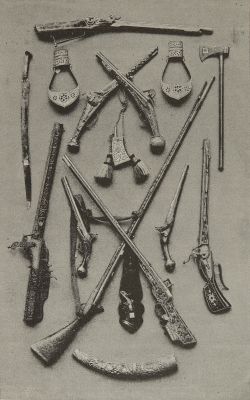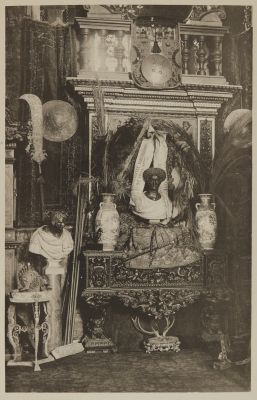
Title
Trophäe Von Musik-Instrumenten.Artist
UnknownPublication
Katalog des künstlerischen Nachlasses und der Kunst-und Antiquitäten-sammlungDate
1885Process
KlićotypeAtelier
Carl KlićImage Size
21.6 x 14 cm
In June 1887, The Art-Journal published an article reviewing the previous fifty years of developments in the production of plate illustrations. The text refers to the newest process being introduced to London as the ‘Klicotype, so named after the inventor, Herr Karel Klíč, formerly of Vienna’ and states the improvements apply ‘equally to the intaglio form of the art as to the relief’. The article included a Klicotype reproduction of a photograph of George Tinworth’s The Last Supper, a terracotta relief sculpture created at the Doulton works in Lambeth. As the illustration is incorporated with the type in the printing of the page, it would appear that here Klíč made a relief Klicotype for the publishers. A previous publication Critical Essay of Tinworth by Edmund Gosse published in 1883 contained excellent but expensive photographic illustrations of Tinworth’s work, reproduced by Goupil’s photogravure process. Klíč may have wished to demonstrate that his process could not only equal Goupil’s in quality but was also a much cheaper alternative as it produced blocks to print alongside type. The article singles out for praise both the Tinworth reproduction and a Klicotype reproduction of the cartoon for The Arts of Peace by Sir Frederick (later Lord) Leighton. Unfortunately the illustration of the Tinworth ceramic is quite heavy and in Klíč’s defence the actual printing would have been outside his control, and the editorial would have been written before the magazine was actually printed! However, despite the more successful reproduction of the Leighton work, the article’s description of the process is adjacent to the less appealing Tinworth reproduction and in consequence the use of a relief Klicotype may not have been read as a sufficiently practical innovation.
We speculate that both the illustrations and the printing blocks were provided to the publisher by Klíč who, as usual, kept his process secret.
In 1892, The British Journal of Photography reported on a lecture at The Photographic Society of Great Britain, part of which focussed on what the speaker described as Photogravure Relief. The article comments that ‘Photogravure has now strangely invaded the letterpress department.’ Unfortunately the account is not very technical, however there is mention of both Goupil, Goupil here referred to as using the Woodbury deposition process – another term for grown plate or sand-grain – and Klíč. How Klíč’s 1889 blocks might have been made is unknown. [1]
References
[1] Roger Farnham and Harry Magee The rise of photogravure in the UK in the 1880s 2015
The Art Journal 1887 p. 211




